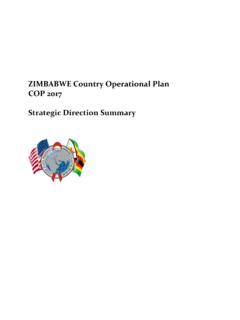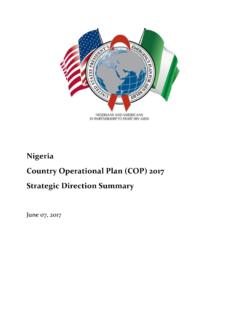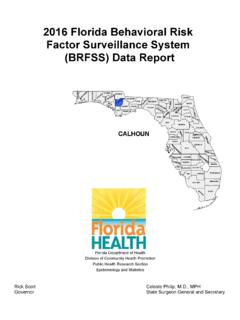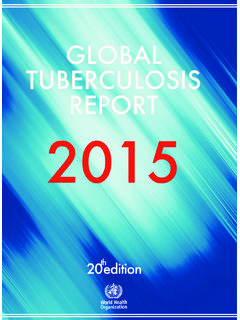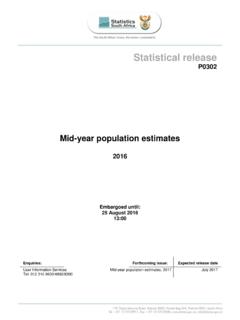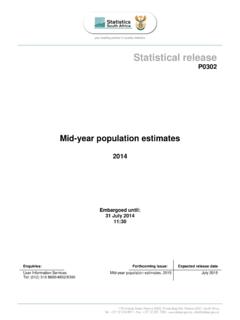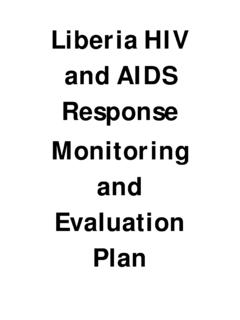Transcription of STRATEGIC TECHNICAL ALIGNMENT FOR RESULTS (STAR) …
1 STRATEGIC TECHNICAL ALIGNMENT FOR RESULTS (STAR) PROCESS Burma Country/Regional Operational Plan (COP/ROP) 2017 STRATEGIC Direction Summary March 2, 2017 Page 1 of 20 Table of Contents Goal Statement Epidemic, Response and Program Context Summary statistics, disease burden and epidemic profile Investment profile Sustainability profile ALIGNMENT of PEPFAR investments geographically to burden of disease Stakeholder engagement Program Activities for Epidemic Control Description of STRATEGIC outcomes Site-level (rationale, geographic and population prioritization) Critical above-site systems investments for achieving sustained epidemic control Description of how PEPFAR will support greater sustainability United States Government Management, Operations and Staffing Plan to Achieve Stated Goals Appendix A - Budget Profile and Resource Projections Appendix B - Focused Outcome and Impact Table (FOIT) Page 2 of 20 Goal Statement The vision for the President s Emergency Plan for AIDS Relief (PEPFAR)
2 In Burma for COP 17 is to support the country s efforts to achieve epidemic control using the 90-90-90 global targets as a framework for HIV program planning and prioritization. PEPFAR in Burma support will continue to focus on TECHNICAL assistance (TA) and targeted support to improve the cascade of HIV prevention, testing and treatment, especially for key populations (KP) affected by high HIV prevalence and limited access to and low coverage of HIV services. PEPFAR in Burma will also assist with strengthening laboratory, health information and supply systems to sustain the program in the long-term. PEPFAR in Burma s overarching goals for FY 18/19 aim to achieve high yield of HIV testing among KP, as well as early enrollment and high rates of retention in treatment services for those who are HIV infected.
3 These goals place particular emphasis on scaling up harm reduction services and medication-assisted therapy (MAT), as well as improving case detection and linkage to treatment for people who inject drugs (PWID). The PEPFAR program in Burma is strategically structured to capitalize on site-level incubator innovations and service delivery models in order to inform higher level TA linked to policy and guideline shifts that support scale-up and impact of HIV programming and resources. To this end, close collaboration with all key in-country actors, including the government, civil society, the community and other stakeholders, such as the Global Fund to Fight AIDS, Tuberculosis and Malaria (Global Fund) and its partners, will be enhanced to identify cutting-edge solutions to national epidemic control challenges, invest in these ideas, test them and work to scale the solutions that promise the greatest impact.
4 Epidemic, Response and Program Context Summary statistics, disease burden and country or regional profile Burma, a sovereign nation bordered by Bangladesh, China, India, Laos and Thailand, is made up of one Union Territory, 14 states and regions, 74 districts, 330 townships and 13,602 village tracts. It has a population of 51,486,253 people and comprises at least 138 ethnic groups. About 89 percent of the population is Buddhist. Burma is one of 35 countries that account for 90% of new HIV infections globally (UNAIDS Fast Track Update on Investments, 2015). Burma has an estimated 224,794 people living with HIV (PLHIV) (AEM, Spectrum 2016).
5 The HIV epidemic in Burma was at its height in 2005, when HIV prevalence reached of the general population. In 2015, HIV prevalence declined to The HIV epidemic in Burma remains concentrated among KP, with HIV transmission primarily occurring among people who inject drugs (PWID), men who have sex with men (MSM), transgender people (TG), and female sex workers (FSW) and their clients. According to the Third Myanmar National STRATEGIC Plan for HIV: 2016-2020 (NSP III), at the end of 2015, 106,490 persons were receiving antiretroviral treatment (ART). This represented 47 percent of all those in need of treatment as specified by national treatment guidelines.
6 With TA provided by PEPFAR and other partners, accelerated ART scale up has started to show RESULTS , and, while the official release is still pending, according to the National AIDS Program (NAP), 127,402 individuals were receiving ART by the end of 2016. The national program has ambitious treatment targets, including having 196,743 individuals on ART by 2020 (NSP III, 2016 NAP). However, supply chain and laboratory systems supporting scale-up need further strengthening, and regular monitoring of RESULTS at all levels does not occur. Important policy and strategy changes in Burma include the transition to Test and Start for all PLHIV, which is a Core activity for COP 16.
7 The existing treatment guidelines currently stipulate a Page 3 of 20 policy of immediate ART for HIV-positive pregnant women, children under 5 years of age, tuberculosis (TB) patients and KP, and the guidelines are being revised with anticipated roll-out of Test and Start for all PLHIV in 2017. Currently available KP size estimates are 66,000 FSW and 252,000 MSM. Based on the RESULTS of the Integrated Bio-Behavioral Survey (IBBS) of PWID, which was completed in 2014, there are an estimated 83,000 PWID in Burma. Data collection for IBBS of FSW and MSM was completed in 2015, and data analysis is ongoing with full release of findings expected shortly; RESULTS of the ongoing national drug user survey will inform PWID activities.
8 Additional data received from other surveys and implementing partners (IPs) will help to improve modeling estimates of the epidemic trends within Burma and facilitate further tailoring of the PEPFAR response. HIV prevalence rates among KP are much higher than those of the general population. As such, the HIV epidemic disproportionately affects KP and their intimate partners. National HIV prevalence is among PWID (NSP III, AEM, 2014 PWID IBBS); among FSW (NSP III, 2015 FSW IBBS draft report); and among MSM (NSP III, 2015 MSM IBBS draft report). Prevalence varies geographically: for example, in the north and north-eastern parts of Burma (Muse (Northern Shan State) and Waingmaw and Bamaw (Kachin State)), nearly one in two PWID who participated in the IBBS in 2014 tested HIV-positive, which is the 5th highest HIV prevalence level among PWID in the Asia/Pacific region.
9 Similarly, HIV prevalence among MSM was 27% in Yangon and 22% in Mandalay; HIV prevalence among MSM in Yangon is the highest in a specific geographical site in the Asia/Pacific region. However, there is limited information at sub-national levels, and the surveillance RESULTS do not include the large parts of the country where there is ongoing civil unrest. Numbers disaggregated by KP are shown in tables and , although concerns about data quality limit their use and interpretation. Despite limitations in data quality, tables and show differences in HIV prevalence between the total population ( ) and KP, with highest prevalence among PWID at This will inform a prioritization of programming in COP 17/18 designed to respond to key PWID prevention and treatment needs.
10 In addition, it points to the need for HIV testing and treatment among patients with TB and sexually transmitted infections (STIs), as there is likely an overlap in risk behaviors: HIV prevalence among TB patients with known HIV status is estimated at 9% (2015, Global TB Report). The HIV Sentinel Surveillance is conducted every two years, with data reported from around 35 of 330 townships. Incidence rates for KP are not available, though estimates and projections of incidence, , new infections, are generated by the AIDS Epidemic Model (AEM) (formerly the Asian Epidemic Model). A large proportion of new infections (29%) is attributable to PWID.


